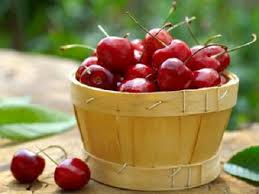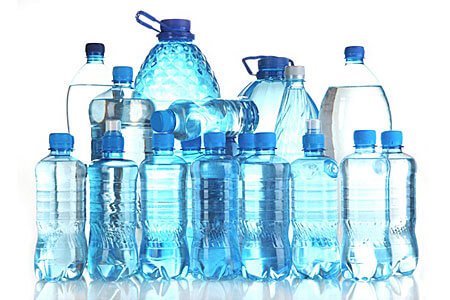Nutrition Q&A: Cherries, America’s Superfruit

Cherries are one of my favorite fruits. With it being cherry season I have been eating them by the pound. Do they provide any health benefits? Not only are cherries satisfying to eat, they provide a wealth of health benefits earning them the title of “Super Fruit”. Cherries have many important health benefits – from helping ease the pain of arthritis and gout, to reducing risk factors for heart disease, diabetes and certain cancers. Cherries can be one of the recommended 5-9 daily servings of fruits/vegetables recommended for cancer prevention and decreased recurrence. Cherries also contain melatonin, which has been found to help regulate the body’s natural sleep patterns, aid with jet lag, prevent memory loss and delay the aging process. The cherry season runs mid May to mid August with June being the peak of the season, so summer is the perfect time to enjoy them fresh. Even though the season is relatively short, they can be eaten all year round weather dried, frozen or as juice. Cherries have among the highest levels of disease-fighting antioxidants, when compared to other fruits. They also contain other important nutrients such as beta carotene (19 times more than blueberries or strawberries) vitamin C, potassium, magnesium, iron, fiber and folate. Cherries’ red color is provided by the fruit’s powerful antioxidants called anthocyanins. Anthocyanins are responsible for providing the many health benefits stated above. They can reduce inflammation, total cholesterol, and can drastically reduce your risk for heart disease. With more than 80 million Americans living with some form of heart disease, the heart-healthy qualities of eating cherries are more relevant than ever. Anthocyanins can also help ease the pain of inflammatory-related conditions such as arthritis, and gout. Cherries’ post-exercise benefits are good news for the increasing number of active adults who feel the aches and pain of post-exercise muscle soreness. These post-exercise benefits are likely because of the fruit’s natural anti-inflammation properties. As of today there’s no established guideline on how many cherries it takes to reap the benefits, but the experts do suggest that 1-2 servings of cherries daily can help provide some of the health benefits identified in the research. Single serving size examples include: • 1/2 cup dried • 1 cup frozen or fresh • 1 cup juice • 1 ounce (or 2 Tbsp) juice concentrate
Nutrition Q&A: Smart Plastics

I’m trying to be good and stay hydrated this summer and, out of convenience, I’ve been grabbing a water bottle out of the fridge on my way out the door and refilling it all day. I know that I should be avoiding BPA, but can you tell me which recycling codes on the bottom of my bottles I need to avoid? BPA stands for Bisphenol A, an industrial chemical used to make polycarbonate plastic resins, epoxy resins, and other products. It is an organic compound that possibly acts similarly to estrogen when ingested into the body. A growing number of health experts and consumers are becoming concerned about the adverse health effects that can be caused from high-dose or long-term exposure to BPA. BPA has been used to harden plastics for more than 40 years. It’s in more things that most people think. We all know that it can be in the lining of canned foods and water bottles, but BPA can also be found in medical devices, compact discs, and even dental sealants. More than 90% of us have BPA in our bodies, coming mostly from eating foods or drinking beverages that have been in containers made with BPA. To decrease your exposure to BPA follow these Tips to help you avoid BPA in plastics: Find products that are BPA-free. It isn’t as hard as it once was. Choose non-plastic containers for food. Containers made of glass, porcelain, or stainless steel do not contain BPA. Do not heat plastic that could contain BPA. Never use plastic in the microwave. Heat can cause BPA to leach out. For the same reason, never pour boiling water into a plastic containers. Hand-wash plastic bottles, cups, and plates. Throw out any plastic products — that are chipped or cracked. They can harbor germs. If they also have BPA, it’s more likely to leach into food. Use fewer canned foods and more fresh or frozen. Many canned foods still contain BPA in the can linings. Avoid plastics with a 3, 6, or 7 recycle code on the bottom. These plastics might contain BPA. Safe codes are 1,2,4 and 5.
Nutrition Q&A: Grilling Meats

Is eating grilled meat safe? The American Institute for Cancer Research (ACIR) expert report says there is not enough evidence to show that grilled meat increases your risk of cancer. But we do know that cooking meat at high temperatures, like grilling, creates cancer-causing substances called polysyclic aromatic hydorcarbons (PAHs) and heterocyclic amines (HCAs). PAHs form when fat from the meat drips onto the hot coals or grill element. They’re then deposited on the food courtesy of flame-ups and rising smoke. Unfortunately, that desired charring that forms on meat can contain PAHs as well. HCAs, meanwhile, are produced when red meat, poultry and fish are exposed to high-heat cooking, like grilling, broiling, or charring. Both PAH and HCA can cause changes in DNA that may lead to cancer according to AICR. Risk of these carcinogenic formations is higher from red and processed meats – like hamburgers and hot dogs. Evidence is clear that diets high in red and processed meats, contribute to an increased risk of colorectal cancer. Based on the evidence, AICR recommends limiting red meat to 18 ounces of cooked meat per week and staying away from processed meats. Guide to Safe Grilling Marinate: Studies have suggested that marinating your meat before grilling can decrease the formation of HCAs. Scientists theorize that the antioxidants in these marinades block HCAs from forming. Pre Cook: If you are grilling larger cuts, you can reduce the time your meat is exposed to the flames by partially cooking it in a microwave, oven or stove first. Immediately place the partially cooked meat on the preheated grill. This helps keep your meat safe from bacteria and other food pathogens that can cause illness. Lean Cuts: Trimming the fat off your meat can reduce flare-ups and charring. Cook your meat in the center of the grill and make sure to flip frequently. Mix It Up: Cutting meat into smaller portions and mixing with veggies can help shorten cooking time. Go Green: Grilling vegetables and fruits produces no HCAs and plant-based foods are actually associated with lower cancer risk. Try this marinade recipe for any kind of meat. Tangy Yogurt-Spice Marinade (Yield: Makes about 1 2/3 cups.) 1.5 cups low-fat yogurt 2 Tbsp. fresh lemon juice 1/4 tsp. cayenne pepper 2 tsp. minced garlic cloves 2 tsp. ground coriander 1 tsp. ground turmeric 2 tsp. minced fresh ginger (or 1 tsp. dried, ground ginger) Salt and white pepper, to taste Place all ingredients in a blender and combine at low speed. Pour into large, wide and shallow non-metal casserole dish or mixing bowl. Add food to be grilled and turn to coat all sides. Cover and refrigerate at least 1 hour. When ready to grill, drain and discard marinade. Thread skewers with food. Grill, turning often to prevent charring. If desired, make additional marinade for basting (but do not baste with used marinade to avoid food poisoning from raw meat juices). Per serving: 23 calories, 0 g total fat (0 g saturated fat), 3 g carbohydrates, 1.5 g protein, 0 g dietary fiber, 22 mg sodium
Nutrition Q&A: Sugars

Q: Can eating sugar cause cancer or increase my chance of recurrence? A: I get asked this question on a daily basis. Presently there is no scientific evidence that directly links sugar consumption and increased risk of cancer, increased tumor growth or increased risk of recurrence. To say sugar causes cancer would be the same as saying sugar causes diabetes. Both are false statements. The data regarding sugar and cancer risk draw their conclusions on information from preliminary studies done with animals and in test tubes, not on human subjects. Recent research has been looking at an individual’s diet along with sugar intake to see how it may affect cancer risk or survivorship outcomes. There has yet to be any randomized, controlled trials showing that sugar causes cancer. What we do know about sugar it that it has no nutritional value. It provides us with nothing but calories. Increased consumption of calories in the absence of physical activity can lead to weight gain. Excess weight has been linked to increased risk of the following cancers: esophageal, pancreatic, colon/rectal, breast (postmenopausal), endometrial, kidney, thyroid and gallbladder. The American Institute for Cancer Research states the following: “Foods and drinks that are high in refined carbohydrates, added sugar, and fat contribute to obesity, a major risk factor for cancer.” Eating too much refined sugar can also cause chronic low-grade inflammation which has been linked to increased cancer risk as well. When we talk about sugar consumption, we are talking about refined sugar, not sugar found naturally in our food, ie lactose in milk or fructose in fruit, so cutting back on these foods is not warranted. Keeping refined sugar to a minimum is hugely important for overall health. The current recommendations are to keep refined/added sugar to 6 teaspoons per day for females and 9 teaspoons per day for males. Americans currently consume 3 to 4 times that much. When reading the food label of your favorite sugary treat, keep in mind the following equation to help you determine how many grams of sugar you are consuming per serving: Take grams of sugar and divide by 4 and it will give you teaspoons per serving. Say for instance the soda you’re about to drink has 44 grams of sugar. 44 divided by 4 = 11 tsp of sugar, which is 1 tsp shy of a ¼ cup. That’s not to mention any other added/refined sugar that shows up in the rest of your food throughout the day. Spend your sugar budget wisely, and when it comes to processed sugar, less is always better. Simply start by cutting out sugary foods such as pies, cookies, candies and eliminating sugary beverages such as soda, sweet tea, and sports drinks.










